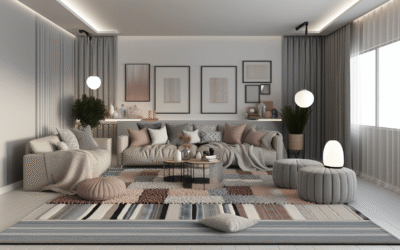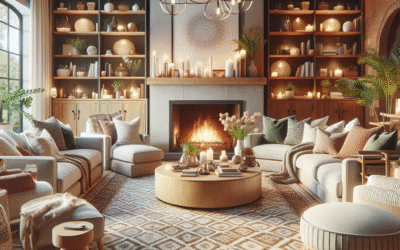
Have you ever stepped into a gallery and felt an instant connection? Often, it’s not just the artwork that captivates; it’s the surroundings. The right runner rugs can elevate your space, enriching both aesthetics and comfort. In this article, we’ll explore the art of choosing runner rugs that not only complement your gallery but also reflect your personal taste.
We’ll cover everything from styles and materials to practical tips on maintenance and placement. By the end, you’ll have a thorough understanding of how to select the perfect runner rug that speaks to your style and enhances your gallery. Ready to transform your space?
Understanding Runner Rugs: A Quick Overview
Runner rugs are elongated rugs typically used in narrow spaces like hallways or galleries. Their design and material vary widely, which allows them to serve both practical and aesthetic roles.
Why Choose a Runner Rug?
- Improves Space Definition: Runner rugs help demarcate different areas within an open concept gallery.
- Adds Texture and Color: They serve as a canvas to introduce patterns, colors, and textures that can tie a room together.
- Enhances Comfort: A soft runner rug can make walking a pleasure and add a level of warmth to colder hard floors.
Types of Runner Rugs
Runner rugs come in various types, which can significantly influence the overall feel of your gallery. Here are some popular types:
- Wool Runner Rugs: Renowned for durability and softness.
- Cotton Runner Rugs: Lightweight and easy to clean, ideal for high-traffic areas.
- Synthetic Runner Rugs: Cost-effective and resistant to stains.
- Silk Runner Rugs: Luxurious yet delicate, perfect for an upscale gallery.
Choosing the Right Style for Your Gallery
Your gallery’s style should resonate throughout. Here’s how to choose the right runner rug style:
Contemporary vs. Traditional Styles
- Contemporary: Bold patterns, geometric shapes, and vibrant colors can introduce a modern touch.
- Traditional: Classic designs with intricate details and muted colors serve as a timeless backdrop.
Matching Colors and Patterns
Select colors that either match or contrast with your gallery. For example, a colorful runner can provide a stunning contrast against neutral walls.
Materials Matter: What to Consider
The material of your runner rug can drastically affect its durability, maintenance, and comfort. Let’s break down the main options:
Natural Fibers
- Wool: Naturally robust, resists stains, and can last for years. Ideal for heavy traffic.
- Sisal: Provides an earthy feel, great for natural aesthetics.
Synthetic Fibers
These tend to be budget-friendly and come in several styles. Polypropylene is a common choice for its durability and stain resistance.
Placement and Maintenance Tips
Optimal Placement in Your Gallery
The placement of your rug can alter the flow and feeling of space. Here are some placement strategies:
- Position runner rugs along walkways to guide visitors visually through your gallery.
- Use rugs to define display areas, drawing attention to featured artworks.
Maintain Your Runner Rug
Keeping your runner rug in top shape requires effort. Regular vacuuming, spot cleaning, and professional cleaning every few years will extend its life.
Case Studies: Real-Life Transformations
Case Study 1: The Eclectic Gallery
A local artist decided to use a colorful printed runner rug that tied in various hues from her artworks. This choice drew visitors deeper into her space and created a cohesive atmosphere.
Case Study 2: The Minimalist Space
A contemporary gallery utilized a simple, neutral runner to maintain a clean aesthetic while ensuring comfort. The rug allowed the artwork to take center stage without distraction.
FAQ Section
What size runner rug should I choose for my gallery?
The size of the runner rug depends on the layout of the space. Ideally, choose a length that extends just a few inches beyond the objects it connects.
How do I clean a runner rug?
For spot cleaning, use a mild detergent with water. For deep cleaning, consult professional services tailored for your rug material.
Can I use multiple runner rugs in one space?
Yes, using multiple runner rugs can help define different areas. Just ensure they complement each other in style and color.
What’s the best material for a high-traffic area?
Wool and synthetic fibers like polypropylene are excellent choices for high-traffic areas due to their durability and resistance to wear.
How can I choose colors for my runner rug?
Opt for colors that complement your gallery’s artwork or the surrounding decor. You can also choose contrasting colors to create visual interest.
Are there any runner rugs recommended for outdoor use?
Yes, look for synthetic fibers designed for outdoor settings, as they are more resistant to weather and easier to maintain.
How often should I clean my runner rug?
It’s ideal to vacuum weekly and schedule professional cleaning every 1-2 years, depending on traffic.
What are the differences between handmade and machine-made runner rugs?
Handmade rugs often have unique designs and higher quality materials, while machine-made options are typically less expensive and uniform.
Conclusion & Next Steps
In conclusion, choosing the right runner rug can significantly enhance your gallery’s atmosphere and functionality. From understanding styles to prioritizing material, each detail counts towards creating a harmonious space. Now that you’re equipped with these insights, it’s time to start your rug transformation journey.
For further exploration, check out our related articles on rug maintenance tips and gallery design ideas.
Content Disclaimer
Information provided is for educational purposes only.
Categories
- Accent Walls & Ceilings (61)
- Art Curation & Gallery (62)
- Bedding Style Trends (68)
- Bedroom Makeover (81)
- Bohemian & Eclectic Styles (58)
- DIY & Budget-Friendly Decor (64)
- Eco-Friendly Design (62)
- Furniture Care (71)
- Home Decor & Design Ideas (162)
- Home Wellness Spaces (59)
- Integrated Outdoor Living (67)
- Japandi Style (61)
- Kids and Nursery Decor (59)
- Living Room Decor (79)
- Mix & Match Techniques (73)
- Modern & Contemporary Design (66)
- Rug Sizing & Placement (73)
- Scandinavian Design Inspiration (20)
- Seasonal Home Decor (79)
- Small Space Solutions (73)
- Wall Art & Painting Tips (77)
Recent Comments
Archives
Product Gallery
-
Large Area Green Rugs for Bedroom Nordic Living Room Decoration Shaped Carpet Irregular Plush Lounge Rug Home Thick Washable Mat
Rated 5.00 out of 5$55.01 – $346.86Price range: $55.01 through $346.86 -
Nordic Style Rugs for Bedroom Morandi Living Room Decoration Carpet Large Area Geometry Lounge Rug Home Cloakroom Non-slip Mat
Rated 5.00 out of 5$39.51 – $598.43Price range: $39.51 through $598.43 -
Irregular Shapes Living Room Decoration Carpet Modern Style Rugs for Bedroom Home Thicken Plush Rug Fluffy Soft Lounge Floor Mat
Rated 4.83 out of 5$55.91 – $347.82Price range: $55.91 through $347.82














